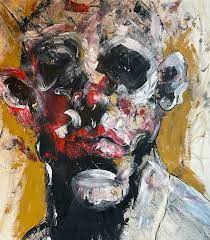Exploring the Enigmatic Realm of Abstract Art
The Intriguing World of Abstract Art
Abstract art is a fascinating and diverse form of artistic expression that challenges traditional notions of representation and invites viewers to explore the realms of imagination and emotion.
Unlike realistic art that aims to depict the world as it appears, abstract art seeks to convey concepts, emotions, and ideas through shapes, colours, and forms that may not directly resemble anything in the physical world.
One of the pioneers of abstract art was Wassily Kandinsky, who believed that colours and shapes could evoke spiritual experiences in viewers. His bold use of geometric forms and vibrant hues paved the way for generations of artists to experiment with non-representational imagery.
Abstract art can take many forms, from the energetic brushstrokes of action painting to the precise geometric compositions of minimalism. Artists such as Jackson Pollock, Mark Rothko, and Piet Mondrian have made significant contributions to the development of abstract art through their innovative approaches and unique visions.
One of the key aspects of abstract art is its ability to engage viewers on a purely visual level, inviting them to interpret and experience artworks in their own way. Each viewer may perceive different emotions or meanings when confronted with an abstract painting or sculpture, making it a deeply personal and subjective form of artistic expression.
Whether you are drawn to the vibrant colours of abstract expressionism or the serene simplicity of geometric abstraction, there is a rich tapestry of styles and movements within abstract art waiting to be explored. By embracing abstraction, artists continue to push boundaries, challenge conventions, and inspire new ways of seeing the world around us.
Exploring the Benefits of Abstract Art: Fostering Creativity, Expression, and Personal Reflection
- Encourages creative interpretation and individual perception.
- Allows artists to express emotions and ideas in a non-literal way.
- Provides freedom from traditional rules of representation.
- Invites viewers to engage with art on a purely visual level.
- Promotes experimentation with form, colour, and composition.
- Challenges viewers to think beyond the obvious and explore deeper meanings.
- Inspires imagination and encourages open-mindedness.
- Offers a diverse range of styles and movements for exploration.
- Creates opportunities for personal reflection and introspection.
Challenges and Criticisms of Abstract Art: Understanding, Interpretation, and Artistic Merit
- Abstract art can be challenging for some viewers to understand or appreciate, leading to a sense of confusion or alienation.
- The subjective nature of abstract art can make it difficult for artists to convey specific messages or themes clearly, resulting in potential misinterpretations.
- Some critics argue that abstract art lacks the technical skill and craftsmanship seen in more traditional forms of art, leading to questions about its artistic merit.
Encourages creative interpretation and individual perception.
Abstract art, with its emphasis on encouraging creative interpretation and individual perception, offers viewers the freedom to engage with artworks in a deeply personal and subjective manner. By presenting shapes, colours, and forms that may not directly represent tangible objects, abstract art invites individuals to explore their own emotions, thoughts, and experiences when encountering a piece. This open-ended nature of abstract art allows for a diverse range of interpretations, making each viewer’s interaction with the artwork a unique and enriching experience.
Allows artists to express emotions and ideas in a non-literal way.
Abstract art offers artists a unique opportunity to express their emotions and ideas in a non-literal way, transcending the constraints of realistic representation. By using shapes, colours, and forms that may not directly correspond to tangible objects or scenes, artists can delve into the depths of their innermost thoughts and feelings, creating artworks that resonate on a deeply emotional level. This freedom from literal interpretation allows for a more nuanced and subjective exploration of complex concepts, inviting viewers to engage with the artwork on a personal and introspective level.
Provides freedom from traditional rules of representation.
Abstract art offers a liberating escape from the constraints of traditional artistic conventions by providing artists with the freedom to explore and express themselves beyond the boundaries of realistic representation. By breaking away from the need to depict objects or scenes in a recognisable manner, abstract art allows creators to experiment with form, colour, and composition in innovative ways that transcend conventional norms. This freedom from strict rules of representation empowers artists to tap into their creativity, emotions, and imagination more freely, resulting in artworks that are truly unique and personal expressions of their inner worlds.
Invites viewers to engage with art on a purely visual level.
Abstract art offers a unique pro by inviting viewers to engage with art on a purely visual level. By stripping away representational elements, abstract artworks encourage viewers to focus solely on colours, shapes, lines, and textures. This approach allows for a more direct and immediate connection with the artwork, enabling individuals to interpret and experience the piece based on their own visual perceptions and emotional responses. In this way, abstract art opens up a realm of subjective interpretation and personal reflection, offering viewers the freedom to explore the artwork through their individual perspectives without the constraints of literal representation.
Promotes experimentation with form, colour, and composition.
Abstract art offers a unique pro in promoting experimentation with form, colour, and composition. By breaking away from representational constraints, abstract artists have the freedom to explore unconventional shapes, bold colour palettes, and innovative compositions. This freedom allows artists to push the boundaries of traditional artistic techniques and challenge viewers to engage with art in new and unexpected ways. Through this experimentation, abstract art continues to inspire creativity, spark dialogue, and expand the possibilities of artistic expression.
Challenges viewers to think beyond the obvious and explore deeper meanings.
Abstract art challenges viewers to think beyond the obvious and delve into deeper meanings that may not be immediately apparent. By presenting shapes, colours, and forms in unconventional ways, abstract artworks encourage viewers to engage with their own interpretations and emotions, fostering a sense of curiosity and introspection. This pro of abstract art invites individuals to explore the complexities of the human experience and encourages them to look beyond the surface to discover hidden layers of meaning and significance within the artwork.
Inspires imagination and encourages open-mindedness.
Abstract art serves as a powerful catalyst for inspiring imagination and fostering open-mindedness. By presenting viewers with non-representational forms and colours, abstract artworks encourage individuals to interpret and engage with the pieces in their own unique way. This freedom of interpretation not only stimulates the imagination but also promotes a more open-minded approach to art and the world at large. Embracing abstract art allows individuals to explore new perspectives, challenge preconceived notions, and appreciate the beauty of creativity beyond traditional boundaries.
Offers a diverse range of styles and movements for exploration.
Abstract art offers a diverse range of styles and movements for exploration, providing artists and viewers with a vast landscape of creative possibilities to delve into. From the dynamic and expressive brushwork of abstract expressionism to the precise geometries of minimalism, each style offers a unique visual language that invites interpretation and introspection. This diversity allows for endless experimentation and innovation, fostering a rich tapestry of artistic expression that continues to evolve and inspire both creators and audiences alike.
Creates opportunities for personal reflection and introspection.
Abstract art creates opportunities for personal reflection and introspection by allowing viewers to engage with artworks on a deeply subjective level. Without the constraints of literal representation, abstract art encourages individuals to explore their own emotions, thoughts, and experiences when interpreting a piece. This process of introspection can lead to moments of self-discovery and contemplation as viewers connect with the artwork in a way that is uniquely meaningful to them. The ambiguity and open-ended nature of abstract art provide a space for personal reflection, inviting viewers to delve into their inner thoughts and feelings, fostering a sense of introspective dialogue between the artwork and the self.
Abstract art can be challenging for some viewers to understand or appreciate, leading to a sense of confusion or alienation.
For some viewers, abstract art can be challenging to understand or appreciate, potentially resulting in feelings of confusion or alienation. The lack of easily recognisable subjects or forms in abstract artworks may make it difficult for individuals accustomed to representational art to connect with the pieces on a personal level. This sense of ambiguity and abstraction can create a barrier for those seeking more concrete narratives or visual cues in art, leading to a feeling of being disconnected from the work and its intended message.
The subjective nature of abstract art can make it difficult for artists to convey specific messages or themes clearly, resulting in potential misinterpretations.
The subjective nature of abstract art can present a challenge for artists seeking to convey specific messages or themes with clarity. Due to the lack of explicit representation in abstract works, viewers may interpret the artwork in various ways, potentially leading to misinterpretations of the artist’s intended meaning. This ambiguity inherent in abstract art can create a barrier between the artist’s vision and the audience’s understanding, highlighting the complex interplay between artistic expression and viewer perception.
Some critics argue that abstract art lacks the technical skill and craftsmanship seen in more traditional forms of art, leading to questions about its artistic merit.
Some critics argue that abstract art lacks the technical skill and craftsmanship seen in more traditional forms of art, leading to questions about its artistic merit. They contend that the absence of recognisable subject matter and the emphasis on non-representational forms may overshadow the importance of honed techniques and mastery of traditional artistic skills. This viewpoint raises concerns about the perceived depth and meaning of abstract artworks, as some critics question whether the apparent simplicity of abstraction truly reflects artistic talent and dedication.


